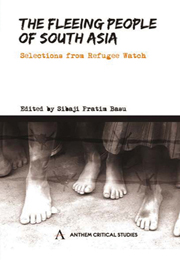Book contents
- Frontmatter
- Contents
- Acronyms and Abbreviations
- Foreword by Ranabir Samaddar
- Preface
- ETHICAL ISSUES
- LAWS
- SOUTH ASIA
- INDIA
- Introduction
- Population Displacement in India: A Critical Overview
- Reporting from Gagan Geer: A Kargil War Refugee Camp
- Barricaded Kashmiri Pandits Letting Go the Right to Return?
- Homeless and Divided in Jammu and Kashmir
- Internal Displacement in North-East India: Challenges Ahead
- The North-East Today: Displacing Identities, Displaced Identities
- Tibetan Refugees in India: Surviving in Exile
- Unrest and Displacement: Rajbanshis in North Bengal
- Adivasis in Coal Mining
- GENDER
- INTERVIEW/CORRESPONDENCE
- REPRESENTATIONS
- Index
The North-East Today: Displacing Identities, Displaced Identities
from INDIA
Published online by Cambridge University Press: 05 March 2012
- Frontmatter
- Contents
- Acronyms and Abbreviations
- Foreword by Ranabir Samaddar
- Preface
- ETHICAL ISSUES
- LAWS
- SOUTH ASIA
- INDIA
- Introduction
- Population Displacement in India: A Critical Overview
- Reporting from Gagan Geer: A Kargil War Refugee Camp
- Barricaded Kashmiri Pandits Letting Go the Right to Return?
- Homeless and Divided in Jammu and Kashmir
- Internal Displacement in North-East India: Challenges Ahead
- The North-East Today: Displacing Identities, Displaced Identities
- Tibetan Refugees in India: Surviving in Exile
- Unrest and Displacement: Rajbanshis in North Bengal
- Adivasis in Coal Mining
- GENDER
- INTERVIEW/CORRESPONDENCE
- REPRESENTATIONS
- Index
Summary
North-east India has been experiencing severe internal displacement since it entered into the postcolonial phase over the past five decades. It also received a steady flow of refugees from neighbouring East Pakistan/Bangladesh, Tibet and Myanmar, fleeing political, social, economic, ideological and environmental persecution. In recent years, however, another problem that has been engaging the attention of social scientists and policy analysts is that of internal displacement. […] For us: ‘Internally displaced persons are persons or groups of persons who have been forced or obliged to flee or leave their homes or place of habitual residence, in particular, as a result of, or in order to avoid the effects of armed conflict, situations of generalised violence, violation of human rights or natural or human-made disasters, and who have not crossed an internationally recognised state border’. […] Society in Assam has historically been multi-racial, multi-religious, multi-ethnic, multi-caste, multi-class and multi-lingual in composition wherein the Asamiyas have constituted the majority national group. Sociologically speaking, Assam's society has been extraordinarily plural in its composition and highly uneven in structure.
Here, we conceptualize the north-east/Assam as a periphery within a larger periphery (India) in the global context. Its peripheral location and its resultant underdevelopment and distorted political response to underdevelopments have made the society in Assam perpetually vulnerable to various kinds of violence, conflict and displacement.
- Type
- Chapter
- Information
- The Fleeing People of South AsiaSelections from Refugee Watch, pp. 259 - 264Publisher: Anthem PressPrint publication year: 2009
- 1
- Cited by



